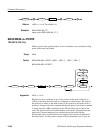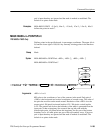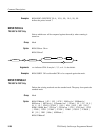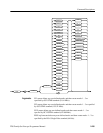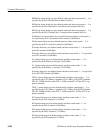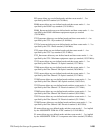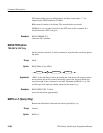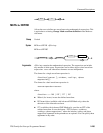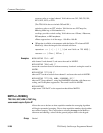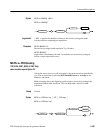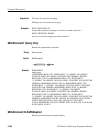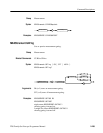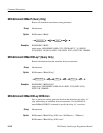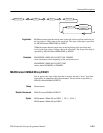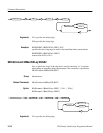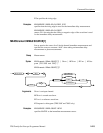
Command Descriptions
2–206
TDS Family Oscilloscope Programmer Manual
<source> refers to a signal channel. Valid choices are: CH1, CH2, CH3, CH4,
REF1, REF2, REF3, or REF4.
(The TDS 410A does not include CH3 and CH4.)
<window> refers to an FFT window. Valid choices are: RECTangular,
HAMming, HANning, or BLAckmanharris.
<scaling> provides vertical scaling. Valid choices are: LOGrms, LINearrms,
DEGreesphase, or RADiansphase.
<Phase suppression> is of the range: –100 dB to 100 dB.
H INTegrate (available on instruments with the Option 2F Advanced DSP
Math only): takes the integral of the selected waveform.
<operator> ::={+|-|*|/(not available on TDS 400A) }
<source> ::= { CH<x> | REF<x> }
MATH2:DEFINE "Ch1 + cH2"
adds channel 1 and channel 2, and stores the result in MATH2.
MATH1:DEFINE "INV( ref4 )"
inverts the waveform stored in reference memory location 4 storing the result in
MATH1.
MATH1:DEFINE "FFT( CH1 )"
takes an FFT on the waveform from channel 1 and stores the result in MATH1.
MATH1:DEFINE "FFT( CH1, HAMM, LINEARRMS, 20 )"
takes an FFT from channel 1, using the HAMMING algorithm, with linear rms
scaling, and 20 dB phase suppression. The result is stored in MATH1.
MATH1:DEFINE?
might return "Ch2*Ref2" as the expression that defines MATH1.
MATH<x>:NUMAVg
TDS 510A, 500C, 600B, & 700C Only,
some models require Option 2F
Allows the user to declare at what acquisition number the averaging algorithm
will begin exponential averaging. Prior to that acquisition number, the algorithm
uses stable averaging. This is equivalent to selecting Average in the Math<x>
side menu and entering a value with the general purpose knob or the keypad.
Vertical
Examples
Group



